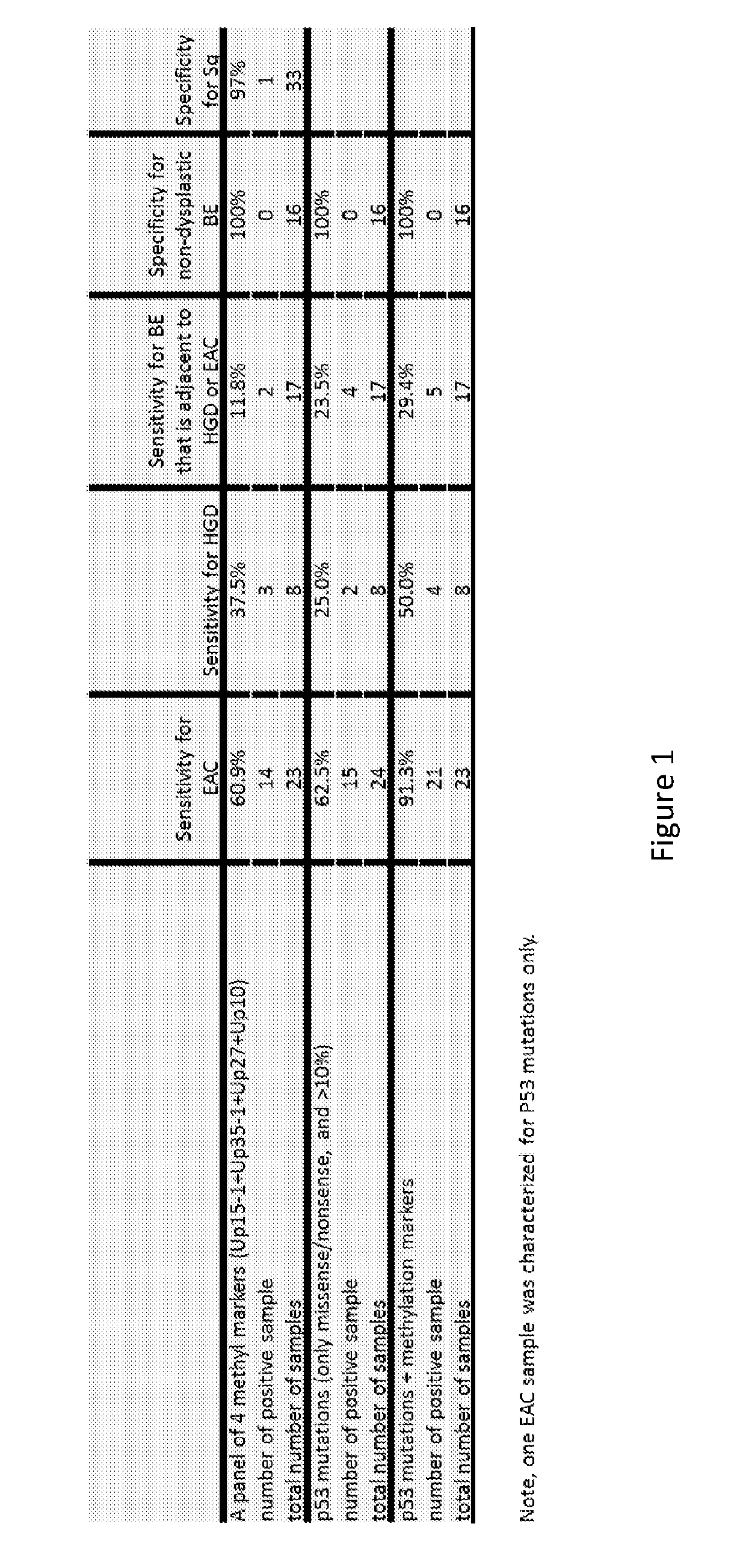Methods and compositions for detecting esophageal neoplasias and/or metaplasias in the esophagus
a technology of esophageal neoplasia and metaplasia, which is applied in the field of methods and compositions for detecting esophageal neoplasia and/or metaplasia in the esophagus, can solve the problems of unsatisfactory methods, false positives, false negatives,
- Summary
- Abstract
- Description
- Claims
- Application Information
AI Technical Summary
Benefits of technology
Problems solved by technology
Method used
Image
Examples
example 1
Identification of Esophageal Cancer Informative Loci
[0180]Methylated informative loci were initially identified using the technique of reduced representation bisulfite sequencing (RRBS) in a discovery set of 23 paired biopsies of normal squamous esophagus and matched esophageal adenocarcinomas, along with biopsies of 8 Barrett's esophagus tissue, and along with brushings of 8 Barrett's esophagus tissues (one BE brushing case also having a matched biopsy).
[0181]Discovery data were initially analyzed for each individual CpG residue in the RRBS data set. Individual CpGs were considered methylated in EAC if they showed methylation in less than 10% of DNA sequence reads in all of the informative squamous samples, where at least 4 squamous samples were informative, where an informative sample had equal to or greater than 20 reads covering the CpG, and if 8 or more of the informative EAC samples demonstrated percent methylation at a level that was at least 20 percentage points greater than...
example 2
Identification of Esophageal Cancer Informative Loci to Detect Progression of Esophageal Neoplasia
[0190]Discovery data were also analyzed for each individual CpG residue in the RRBS data set to identify loci that could be used to distinguish EAC from BE. Individual CpGs were considered methylated in EAC versus BE if they showed methylation of less than 10% of reads of all informative BE samples, where at least 3 BE samples were informative, and if they showed methylation of less than 10% of reads of all informative normal squamous samples, and where an informative sample had equal to or greater than 20 reads covering the CpG, and if 6 or more of the EAC samples demonstrated percent methylation at a level that was at least 20 percentage points greater than the methylation level of the most methylated BE sample. CpGs meeting criteria for methylation in EAC versus and BE are defined as methylated in EAC vs BE. Such methylated CpGs were then aggregated into patches in instances in which...
example 3
Identification of Esophageal Cancer Informative Loci to Detect Progression of Esophageal Neoplasia
[0199]Biopsy samples (that overlapped with the confirmatory biopsy sample set) were further analyzed in tests of panels of markers for detecting the progression of Barrett's esophagus to Barrett's esophagus high grade dysplasia (HGD) or to esophageal adenocarcinoma (EAC). For each panel of markers, FIG. 1 shows the sensitivity (percentage of samples detected), the specificity (percentage of samples not detected), the total number of samples studied, and the total number of positive samples. Three panels of markers were selected for study. The first marker panel consisted of detecting at least one of the following four methylated markers: Up15-1, Up35-1, Up27, and Up10 (using bisulfite sequencing analysis of the corresponding amplicons and using the criteria for detection specified in table 2A). The second panel consisted of testing for somatic non-synonymous mutations in TP53 in assays ...
PUM
| Property | Measurement | Unit |
|---|---|---|
| Fraction | aaaaa | aaaaa |
| Fraction | aaaaa | aaaaa |
| Fraction | aaaaa | aaaaa |
Abstract
Description
Claims
Application Information
 Login to View More
Login to View More - R&D
- Intellectual Property
- Life Sciences
- Materials
- Tech Scout
- Unparalleled Data Quality
- Higher Quality Content
- 60% Fewer Hallucinations
Browse by: Latest US Patents, China's latest patents, Technical Efficacy Thesaurus, Application Domain, Technology Topic, Popular Technical Reports.
© 2025 PatSnap. All rights reserved.Legal|Privacy policy|Modern Slavery Act Transparency Statement|Sitemap|About US| Contact US: help@patsnap.com

